written and photographed by Mary L. Peachin
Dec 2004, Vol. 9 No. 3
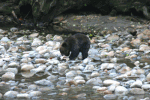 “Grizzlies headed our way, watch out!” Two bears chasing a sow and her cub separated us by a 75-foot stream. “Bearmaster” Tom Rivest, a biologist and owner of Great Bear Nature lodge and tours, quietly stood up from his perch on a riverside log. Tall and lanky, his body language backed up with a double-barrel 12-gauge shotgun, he quietly and firmly said “hey, bears”. The bears, successful in chasing off the sow and cub, respond to Tom’s bluff, and resume their banquet of salmon. Casually he asked, “how was that for excitement”?
“Grizzlies headed our way, watch out!” Two bears chasing a sow and her cub separated us by a 75-foot stream. “Bearmaster” Tom Rivest, a biologist and owner of Great Bear Nature lodge and tours, quietly stood up from his perch on a riverside log. Tall and lanky, his body language backed up with a double-barrel 12-gauge shotgun, he quietly and firmly said “hey, bears”. The bears, successful in chasing off the sow and cub, respond to Tom’s bluff, and resume their banquet of salmon. Casually he asked, “how was that for excitement”?
In six years of operating Great Bear Nature tours on Smith Inlet, Tom has never been in a similar potentially dangerous charging situation, that frightening moment when he had to warn his clients to “watch out.” Close up photographs were a requirement for Paris nature videographers Jehanne and Didier LaCoste. That is why four of us happen to be sitting on the rain sodden bank of the Nekite River instead of in a blind or inside Great Bear’s bus. Tom stood guard with his shotgun and a flashlight-size can of pepper spray (he has never used either).
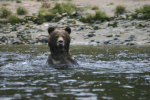 Suddenly twin sub adults (teenagers), their heads upright, float by us headed downriver. Bears and humans carefully eye one another. The bears drift to the willow covered island mid-river which narrows to a sandy spit. Reaching the beach, they splashed through the river to the other side of the river, then scramble into the woods. Wondering if our clicking cameras had frightened them, Tom reminded us that grizzlies are afraid of humans. Hmm, maybe we outglared them. He recalled a time when a sow, weary of mating, used his group as a shield. The bear ran past, leaving them to deal with a chasing erotic male. “In that situation, you simply step aside, and let them pass.” Right!
Suddenly twin sub adults (teenagers), their heads upright, float by us headed downriver. Bears and humans carefully eye one another. The bears drift to the willow covered island mid-river which narrows to a sandy spit. Reaching the beach, they splashed through the river to the other side of the river, then scramble into the woods. Wondering if our clicking cameras had frightened them, Tom reminded us that grizzlies are afraid of humans. Hmm, maybe we outglared them. He recalled a time when a sow, weary of mating, used his group as a shield. The bear ran past, leaving them to deal with a chasing erotic male. “In that situation, you simply step aside, and let them pass.” Right!
“Can you smell the pungent odor of the bear”? No. The decomposed fish at my feet overwhelmed any bear scent. This time the floating bear didn’t stare us down. It ravenously stopped to fish on the sandy beach. On the far bank, another bear growled. Tom anticipated our question. “She can’t find her cub.”
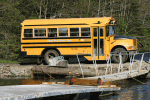 We heard a yelp. A mother bit one of the cubs on the bum. My heart continued to pound. This is more than the usual action. Tom tells us, “if this river wasn’t separating us from the bears, we wouldn’t be safe here.” By the time they swim across the river, we can get their attention. “I don’t want them using this bank as their exit path. Bear will chase each other, but one usually outruns the other.” Older bears, unable to run, are the ones that tend to fight and claw one another.
We heard a yelp. A mother bit one of the cubs on the bum. My heart continued to pound. This is more than the usual action. Tom tells us, “if this river wasn’t separating us from the bears, we wouldn’t be safe here.” By the time they swim across the river, we can get their attention. “I don’t want them using this bank as their exit path. Bear will chase each other, but one usually outruns the other.” Older bears, unable to run, are the ones that tend to fight and claw one another.
Tom smells their rank odor before he sees or hears their presence (the snapping of a nearby twig). When he suspects a bear has remained in close proximity, hidden by dense temperate rainforest, he turns his bearded six-foot frame in their direction and calmly says “hey bear, hey bear.” If he doesn’t think they’ve moved on, he’ll continue, “go around us, bear.” Rivest has identified 35 bears in the Smith Inlet and named about ten of them. He thinks approximately 50 bears inhabit the Nekite valley.
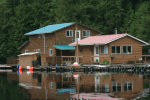 During a three day visit, six o’clock wake up call was a gentle knock on the door. After a quick cup of coffee and a muffin, we hurried up a slick dew-covered pier before daylight. Eight of us (a pair of Italians, French, Canadian, and Americans) piled into a yellow 1992 Bluebird coach with eager anticipation. The fourteen passenger school bus is functional because its windows open (allowing for clearer photography.) Slowly we bumped through ruts and potholes on the abandoned logging road in the pre-dawn. The six mile road is carved in a forest of red alders, western hemlock, red cedar, and ferns. The going is slow (5-10 mph), it is almost an hour before we stop at a wide spot in the river. A willow-covered island divides the river giving the bears more room to fish.
During a three day visit, six o’clock wake up call was a gentle knock on the door. After a quick cup of coffee and a muffin, we hurried up a slick dew-covered pier before daylight. Eight of us (a pair of Italians, French, Canadian, and Americans) piled into a yellow 1992 Bluebird coach with eager anticipation. The fourteen passenger school bus is functional because its windows open (allowing for clearer photography.) Slowly we bumped through ruts and potholes on the abandoned logging road in the pre-dawn. The six mile road is carved in a forest of red alders, western hemlock, red cedar, and ferns. The going is slow (5-10 mph), it is almost an hour before we stop at a wide spot in the river. A willow-covered island divides the river giving the bears more room to fish.
 Tom has cautioned us about bear safety. Before leaving the lodge, he emphatically tells us to always remain calm and cool, no camera flashes are allowed, stay together and always keep him between any approaching bears. “When you spot a bear, don’t point at it, they can see you.” Grizzlies are well behaved and “if you behave predictably, they’re happy.” “It’s all a question of bluffing. They don’t know our strength, so as long as we don’t act afraid, they won’t bother us.”
Tom has cautioned us about bear safety. Before leaving the lodge, he emphatically tells us to always remain calm and cool, no camera flashes are allowed, stay together and always keep him between any approaching bears. “When you spot a bear, don’t point at it, they can see you.” Grizzlies are well behaved and “if you behave predictably, they’re happy.” “It’s all a question of bluffing. They don’t know our strength, so as long as we don’t act afraid, they won’t bother us.”
Great Bear’s cedar bark blinds provide stable conditions that keep bear unaware and viewers feeling secure. The blinds and bus are the usual circumstances for observing bears with Great Bear Nature tours.
The current of the Nekite river churns with thrashing, spawning chum salmon, many already dead or decomposing along the bank. “Get use to that putrid ‘road kill’ smell. It will be the aroma of the next three days.” The river scene is a feeding frenzy, period. Squawking sea gulls, oblivious to several grizzlies feasting nearby, scoop the river bottom for salmon eggs. The first grizzly we see appears from behind the willows on the bank, a mere 75 feet from us. My heart leaps into my throat.
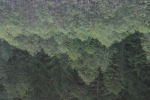 Bear behavior is interesting to observe. By their third year, most sow abandon their cubs leaving them fend for themselves. One sow is with a large male cub. “He is a bear that should be out on his own.” Together, they have strength in numbers for fending against other bears. A cub makes a false charge bluffing another male. Upstream a lone female is gorging in a pool of spawning salmon, “happy to be feasting alone.”
Bear behavior is interesting to observe. By their third year, most sow abandon their cubs leaving them fend for themselves. One sow is with a large male cub. “He is a bear that should be out on his own.” Together, they have strength in numbers for fending against other bears. A cub makes a false charge bluffing another male. Upstream a lone female is gorging in a pool of spawning salmon, “happy to be feasting alone.”
Greater Bear’s floating lodge is a 100-miles from civilization. It sleeps eight guests in five private bath rooms. Two shared showers are located downstairs. Margaret and Tom along with helper/biologist, Suzanna Ritchie, always wear bear spray slung around their waist. The ambience is family-style. Help yourself to water, coffee, fresh fruit or cookies. After a mid-morning breakfast of cereal, yoghurt, toast, fresh fruit, and hard-boiled eggs, we have time to kayak, take a boat tour, check the lodge’s Dungeness crab trap, or just hang out. Dinner is served from a salad bowl and food platters placed on the table.
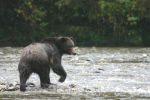 The entree might be salmon enchiladas, cedar-planked barbecue sockeye salmon, or paella served with Dungeness crab, a daily catch from the lodge’s estuary trap. A bubbly, personable Aussie, Margaret serves dinner with her favorite Australian wines. Dessert is also homemade.
The entree might be salmon enchiladas, cedar-planked barbecue sockeye salmon, or paella served with Dungeness crab, a daily catch from the lodge’s estuary trap. A bubbly, personable Aussie, Margaret serves dinner with her favorite Australian wines. Dessert is also homemade.
Another day, Margaret was our guide. A bear walked down the road then scrambled down the river bank. To answer a guest’s question, Margaret stopped by the side of the road pointing to several scooped-out areas. “This is where a bear and cub having been sleeping. They cleared the brush to flatten the ground. “Like humans, they like to sleep comfortably.”
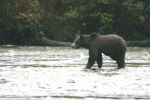 As exciting as it was seeing more than half a dozen bears during a three hour outing, we experienced a sunny afternoon when there was not a bear in sight. Nothing! Other than sitting comfortably on lawn chairs in a cozy cedar blind above the river admiring beautiful scenery, the highlight was seeing a flock of mergansers and a Stellar jay. Finally, after two and a half hours, we were rewarded for our patience. A sow with three spring cubs lumbered out of the willows to feed in the river. Occasionally the two cubs would snarl and fight over a salmon? The next moment they would playfully lick one another. By day’s end, we had seen sixteen bears. Another morning we watched bears from the bus. Away from the high density of bears, Tom took us for a walk along the road pointing out bear tracks and introducing us to Freebee. The four year old sow appears to be more accustomed to humans. Unfortunately, she stays on the far side of the river.
As exciting as it was seeing more than half a dozen bears during a three hour outing, we experienced a sunny afternoon when there was not a bear in sight. Nothing! Other than sitting comfortably on lawn chairs in a cozy cedar blind above the river admiring beautiful scenery, the highlight was seeing a flock of mergansers and a Stellar jay. Finally, after two and a half hours, we were rewarded for our patience. A sow with three spring cubs lumbered out of the willows to feed in the river. Occasionally the two cubs would snarl and fight over a salmon? The next moment they would playfully lick one another. By day’s end, we had seen sixteen bears. Another morning we watched bears from the bus. Away from the high density of bears, Tom took us for a walk along the road pointing out bear tracks and introducing us to Freebee. The four year old sow appears to be more accustomed to humans. Unfortunately, she stays on the far side of the river.
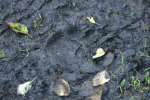 During a visit to a second blind, hand built by Margaret and Tom, on the confluence of the Piper and Nekite rivers, we observed another sow with two spring cubs plus a shy male that would grab a salmon and dart back into the forest. Poor Vincent is past his studly prime. Missing his left ear (and named after Van Gogh), he has a scarred rump and tumor on his foot. Wandering slowly up the river, Tom estimated that he was probably 20 years old (life expectancy is a maximum 30 years).
During a visit to a second blind, hand built by Margaret and Tom, on the confluence of the Piper and Nekite rivers, we observed another sow with two spring cubs plus a shy male that would grab a salmon and dart back into the forest. Poor Vincent is past his studly prime. Missing his left ear (and named after Van Gogh), he has a scarred rump and tumor on his foot. Wandering slowly up the river, Tom estimated that he was probably 20 years old (life expectancy is a maximum 30 years).
During spring, Great Bear clients view bears along the Nekite estuary by boat. When they first come out of winter hibernation, days are spend hungrily feeding on carcasses caught by winter avalanches, Lyngye’s sedge (a protein-rich grass), and skunk cabbage.
The Smith Inlet grizzly is darker in color than those in BC’s interior because of rainforest habitat and lack of sun bleaching. The bear is similar in size to the Alaska bear. Grizzlies may have a fierce reputation, yet Tom is the first to show respect for them. As for those of us who had the thrill of his guidance and expertise, well, we always stayed behind him. Along any future paths in bear habitat, we’ll be saying like he did, “hey, bear.”
As we finished dinner, Suzanna interrupted to tell us “wolves are howling.” We walk onto the deck where a full moon cast a reflection of mountain shadows on the flat water of Smith Inlet. As a bank of fog drifted low overhead, echoes of a pack of Coastal grey wolves howled from the forest. It was magical.
If you go:
Getting to Great Bear is part of the adventure. Two of us climbed into a four passenger single engine Cessna 185 in Port Hardy in northern British Columbia. Dockside we signed an extensive liability release that included the cost of any bear rescue. The 30-minute flight over Queen Charlotte Strait to Smith Inlet is a spectacular landscape of fiords and small islands covered with old or, if logged, second growth forest. Pilot Joey Eilertsen loves to share the history of the area. Flying over Deserters Islands, Joey told how the island was named by the Bull Harbor native band after they misunderstood the Captain’s request to capture and instead beheaded several ship deserters. In 1792, Captain George Vancouver explored the area. Seymour Inlet allegedly has the swiftest current in North America, one that flows at 30 mph. Cape Caution is the Northernmost island. “It’s a bad chunk of real estate, Joey tells us. “It gets gale force open ocean wind. Another option to reach Great Bear is a 2-3 hour water taxi that includes seasonal whale watching.
Great Bear Lodge is located 50 air miles northeast of Port Hardy, British Columbia. 1-888.221.8212 250.949.9496 info@greatbeartours.com or www.greatbeartours.com Daily rates start at $762.00 per person (spring) to $5381 (fall) for seven nights. Prices are all-inclusive including transportation by air (30-minutes) or water taxi from Port Hardy.
Air Canada provides air service to Port Hardy from Victoria and Pacific Costal Airlines flies there from Vancouver. The drive from Victoria to Port Hardy is about six-seven hours.
What to bring: layers of polypropylene and fleece, hiking boots, jacket, and rain gear. Dress is jean casual. The day’s schedule revolves around the morning and afternoon safaris, casual and flexible.
Lodging: If overnighting in Port Hardy, Bear Cove Cottages has log cabins with kitchenettes and fireplaces. Seasonal rates vary from $75-125.00 per night. Call 877.949.7939 or www.bearcovecottages.com
